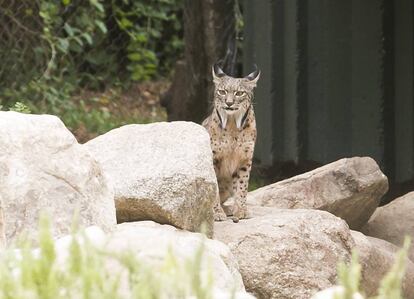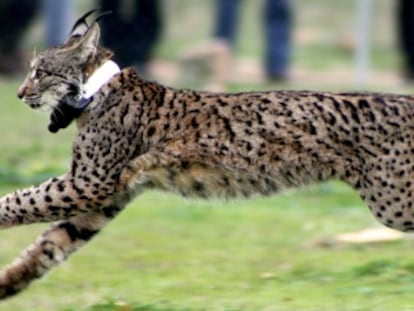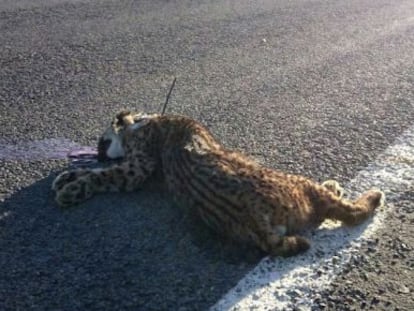Two Iberian lynxes move into Madrid Zoo
Royals and government officials attend the inauguration of new facilities for this endangered Spanish feline

Two Iberian lynxes are the new residents of Madrid’s Zoo Aquarium, which inaugurated special facilities for the endangered species on Wednesday.
King Felipe VI’s mother, Sofia, who still holds the honorary title of queen, attended the event along with state and regional officials.
The male, Kalama, and the female, Jazmín, are the only Iberian lynxes to live in the Madrid region. Most of the others are in southern Spain, particularly in Doñana National Park, where there is a breeding program in place to save the species.
The breeding program has raised the number of specimens in two Andalusian locations from 100 in 2002 to 361 in 2015
The three and four-year-old animals were transferred to their new 600 m2 residence from a breeding center in Zarza de Granadilla (Cáceres).
Jesús Fernández, director of the zoological division of Parques Reunidos, the parent company of Madrid’s Zoo Aquarium, explained that “because they are not fit for reproduction purposes, the lynxes will fulfill another one of the program’s goals, which is raising social awareness about the dangers threatening this species.”
With this initiative, the Zoo Aquarium and the Parques Reunidos Foundation are joining the Life Iberlince conservation program, which is run jointly by the Environment Ministry and the regional government of Andalusia. This program has managed to reduce the Iberian lynx’s status from “critically endangered” to “endangered.”
Sign up for our newsletter
EL PAÍS English Edition has launched a weekly newsletter. Sign up today to receive a selection of our best stories in your inbox every Saturday morning. For full details about how to subscribe, click here.
The Andalusian environment chief, José Fiscal, said that the breeding program has raised the number of specimens in two Andalusian locations from 100 in 2002 to 361 in 2015. In the whole of the Iberian peninsula there are 404 animals after some of them expanded into Castilla-La Mancha, Extremadura and the neighboring Portugal.
Agriculture Minister Isabel García Tejerina underscored that “lynx conservation is one of the prime examples in the history of nature protection in Spain.”
She added that the coordinated work of all agencies involved in the project has yielded excellent results throughout these last 15 years.
Agustín López Goya, biology director for Parques Reunidos, explained that the main threats to the Iberian lynx are vehicle strikes on roads and a decline in wild rabbit populations through disease.
“Lynxes feed on rabbits, and if these are ill the lynx is usually affected as well, and its own population declines notably,” added this expert.
English version by Susana Urra.
Tu suscripción se está usando en otro dispositivo
¿Quieres añadir otro usuario a tu suscripción?
Si continúas leyendo en este dispositivo, no se podrá leer en el otro.
FlechaTu suscripción se está usando en otro dispositivo y solo puedes acceder a EL PAÍS desde un dispositivo a la vez.
Si quieres compartir tu cuenta, cambia tu suscripción a la modalidad Premium, así podrás añadir otro usuario. Cada uno accederá con su propia cuenta de email, lo que os permitirá personalizar vuestra experiencia en EL PAÍS.
¿Tienes una suscripción de empresa? Accede aquí para contratar más cuentas.
En el caso de no saber quién está usando tu cuenta, te recomendamos cambiar tu contraseña aquí.
Si decides continuar compartiendo tu cuenta, este mensaje se mostrará en tu dispositivo y en el de la otra persona que está usando tu cuenta de forma indefinida, afectando a tu experiencia de lectura. Puedes consultar aquí los términos y condiciones de la suscripción digital.
More information
Últimas noticias
From Andorra to Gibraltar, a black market for Ozempic exploits its success: ‘They’re the most sought-after products in the world’
Magnets in their heads: How some animals guide themselves using the Earth’s magnetic field
From Hungary’s Orbán to Chile’s Kast: How Trump helps turbo charge the far right
The brief rise and retreat of Generation Z in Mexico
Most viewed
- Why we lost the habit of sleeping in two segments and how that changed our sense of time
- Trump’s obsession with putting his name on everything is unprecedented in the United States
- Charles Dubouloz, mountaineering star, retires at 36 with a farewell tour inspired by Walter Bonatti
- Venezuela faces its most tense Christmas yet
- The Florida Keys tourist paradise is besieged by immigration agents: ‘We’ve never seen anything like this’











































